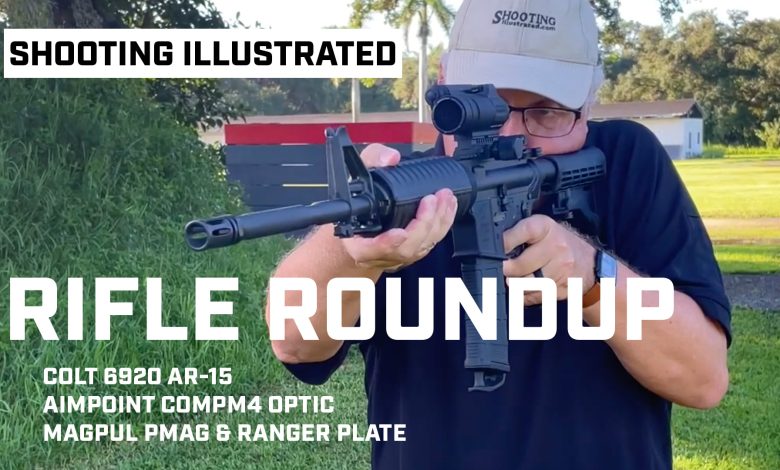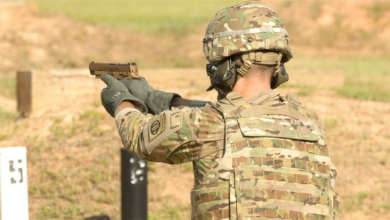Rifle Roundup: Colt 6920 AR-15 With An Aimpoint CompM4 Optic

What is an AR-15? It’s a simple question, with a not-so-simple answer. In many ways, an AR-15 is whatever you make of it. Over the past few months, we’ve shown that an AR-15 can be a long-range precision rifle, a hunting rifle, a great home defense gun or just something to take to the range for the sheer love of the shooting sports. However, when you think of an AR-15, what gun are you actually thinking of? For many people, that answer is what we have in this edition of Rifle Roundup.
Colt CR6920 AR-15 (MSRP: $1,099)
The name “Colt” has been stamped into AR-15s longer than any other gun manufacturer out there, and Colt still knows how to build a first-rate AR. The CR6920 model we’re showing is the semi-automatic version of the baseline service rifle for law enforcement agencies across the country.
The CR6920 has a 16.1-inch-long government profile barrel with a 1:7 twist rate, which is well-suited to every type of 5.56 NATO round you could think of, expect for maybe lighter, 40-grain varmint rounds. At the end of the barrel, there is an A2 “birdcage” flash hider, and underneath the gas block is a bayonet lug. The front sight is integral to the gas block, and the polymer handguard isn’t free-floated and is remarkably free of M-Lok slots. This means that the handguard is very light and very easy to hold on to, two important points that are getting lost in our rush to hang more and more accessories off the front of our rifles.
That’s not to say that the CR6920 can’t be upgraded. It is an AR-15, after all, and can be altered to suit your preferences and needs. To that end, the upper receiver in topped with a section of Picatinny rail so you can mount your choice of optic, and until that happens, there is a Magpul BIUS rear sight to serve as an iron sight. The stock is a collapsible M4-style stock, which adds to the “no-nonsense” approach that Colt has taken to this gun. if you’re looking a solidly built AR that skips the bells and whistles, the CR6920 might be just what you’re looking for.
Aimpoint CompM4 Red Dot Sight: (MSRP: $1,029)
There’s a lot to be said for choosing the “first mover” in any field when you’re looking to buy something new, and Aimpoint has been a leader in red dot sights for longer than most of their competitors. The CompM4 is a prime example of why this is so. Known has the M68CCO (Close Combat Optic) in military service, it’s optic you choose if you’re headed to someplace where things might get a little (or a lot) spicy around you.
The CompM4 has a 2 MOA dot size and is good for over 80,000 hours of constant operation. That’s over 8 years, a feat that is possible because the sight uses a AA battery for illumination, not a button cell that will burn brightly but fade out quickly. There are nine daylight illumination settings and seven settlings for use with night vision gear, which speaks to who is actually uses these sights and why they need so many low-light settings. Speaking of such things, the CompM4 is submersible to 150 feet. Yes, you read that correctly. As a result, a short rainstorm during a range session becomes somewhat less of a crisis if a CompM4 is on top of your rifle.
That ruggedness does come at a price, however, as the CompM4 is quite large compared to many 1x red dot sights and weighs a not-inconsequential 9.4 ounces.
Magpul PMag Gen 3 and Ranger Plate (MSRP: $14.95 [PMag]; $24.95 [Ranger plate three-pack])
There’s a simple explanation why Magpul PMags have become the default magazine option for some many military groups, law enforcement agencies and armed citizens: They work. The toughness and rigidity of a polymer shell, combined with an improved follower for more reliability and a textured outer layer helped the PMag dominate the AR-15 magazine market.
PMags are available with followers optimized for just about every caliber you can use with an AR-15, but the versions we’re looking at the most common and feed .223 Rem./5.56 NATO rounds into an AR-15.
The Gen 3 PMag is a little thicker than the previous Gen 2 version, which in turns improves its ruggedness. There is more texturing on the outside for a better grip on the magazine, and inside, there is an improved follower for more reliability.
The baseplate of a Gen 3 PMag can be replaced by a Ranger Plate, which serves two purposes. The extended polymer loop gives you more to hang on as you pull a magazine out of a chest pouch, and that loop can be used an improvised monopod when shooting from prone or some other stable position.
Read the full article here







